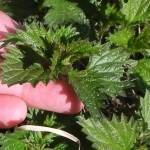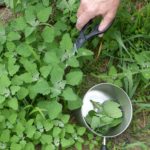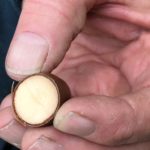by Winding Pathways | May 19, 2022 | (Sub)Urban Homesteading, Foraging, Garden/Yard, Weeds
Yes! The blossoms and leaves have vital nutrients and were cultivated by our European ancestors. In the modern world, every year homeowners spend money and elbow grease to poison their lawns all to try to rid their lawn of dandelions. They could sell the dandelions instead!
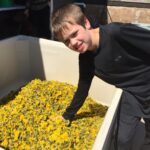
You can make money selling dandelion blossoms.
What? Sell dandelions? The Ackerman Winery in Amana, Iowa, crafts delicious dandelion wine. To make it they need thousands of the plant’s golden blooms and they pay $8 a gallon for them.
The dandelion season has faded for the 2022 spring, but we’ve seen lawns with many dollars’ worth of blooming dandelions that could have been sold. For information on how to buy dandelion wine or sell dandelions go on the Ackerman Winery website.
About Dandelions
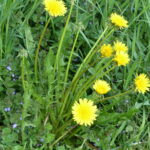
By mid-summer dandelion leaves are tough and bitter.
Dandelions are an amazing plant. Native to the Old World, their seeds were brought to America on the Mayflower. For thousands of years, people considered them a valuable resource. By late winter people often suffered from vitamin deficiency. Dandelion leaves are rich in vitamins and green up in early spring. People ate them to restore their health. They are as nutritious today as they were in the past.
Only in recent years have dandelions been considered pests. Because they are prolific, common, and easy to identify, chemical companies encouraged people to view dandelions as pests so they could sell herbicides.
How silly it is to spend money to kill plants that are good to eat and so nutritious. Thanks to Ackerman Winery they can even add to a family’s income.
How People Unwittingly Encourage Dandelions
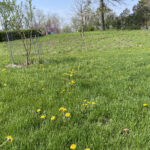
Mowing low encourages dandelions.
Observation reveals a dandelion secret. They thrive on mowed lawns and rarely grow in prairies, woods, or wetlands. Mowing invites dandelions to move in, and chemical companies are ready to sell potions designed to kill a plant with a remarkable relationship with people. A natural way to reduce dandelion numbers in a lawn is simply to set the mower to cut at its highest level. It leaves the grass a big shaggy but their leaves shade the ground and discourage dandelion growth.
We enjoy dandelions at Winding Pathways and steam young tender leaves every spring.
by Marion Patterson | May 12, 2022 | Birds, Garden/Yard, Nature, Trees
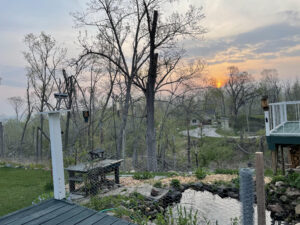 The distant view and the feel are “Hot August Days.” The near view and sounds are mid-May. With this hot weather, the trees have popped, the fruit trees are in full bloom, and the early garden plants emerging after the cooler and damp weather. We may break a century-old heat record today.
The distant view and the feel are “Hot August Days.” The near view and sounds are mid-May. With this hot weather, the trees have popped, the fruit trees are in full bloom, and the early garden plants emerging after the cooler and damp weather. We may break a century-old heat record today.
Two days ago we had the woodstove running. Now the air conditioner!
Notice the haze in the distance and the sun rising in the east – still six weeks from the Summer Solstice. Humidity levels are high. Winds are calmer after the front blew in.
The trees show emerging leaves and catkins. Insects work the fruit trees and low-growing spring flowers.
Birds are everywhere singing, courting, mating, and building nests. Amazing transformation in two days.
-
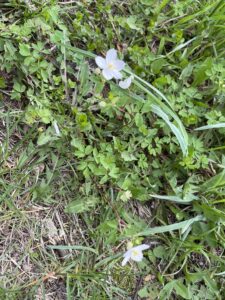
-
Deeply cut leaves of the false rue anemone.
-
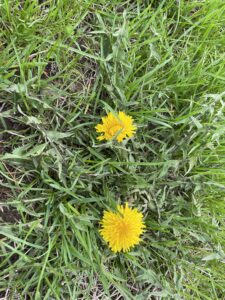
-
going at $8.00 per gallon at wineries, picking blooms from safe places is good income.
-
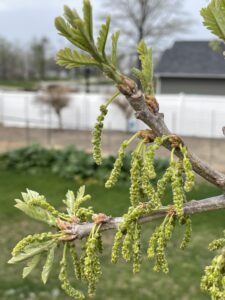
-
the oak popped out in one day with the heat.
-
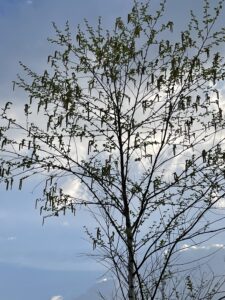
-
birds forage in emerging buds.
by Winding Pathways | Apr 28, 2022 | (Sub)Urban Homesteading, Chickens, Foraging, Garden/Yard, Garden/Yard, Weeds
We are shocked by the rise of many prices, especially food. Fortunately, we mute the cost by finding or growing groceries here at Winding Pathways. We’re lucky to own two acres, but folks living on tiny lots can produce an amazing amount of food, even if they aren’t passionate gardeners.
In a nutshell here’s what we do to tame grocery bills:
Foraging
It’s ironic that many people consider the most delicious and easy wild foods pests and spend time and money trying to eliminate them. We eat ‘em. Books and websites, including Winding Pathways, share tips on finding, identifying, harvesting, cooking, and eating wild foods. Caveat: ALWAYS check that you have the correct plant, gather from unpolluted places, and consume only a small amount initially to be sure your body accepts the wild edible.
Here are our favorites:
Gardening
We’re not passionate gardeners and we don’t can or freeze vegetables, so here’s what we do:
- Succession plant: Our small garden yields an enormous amount of food. We don’t let a square foot be idle. When summer’s heat turns lettuce bitter, we pull it, feed it to our chickens, and plant beans or another heat-loving crop. Same with other crops that grow quickly and then fade.
- Use vertical space: Pole beans, for example, produce much more food per square foot than bush beans, so we choose climbers and use vertical space. We have the pole high enough to reach up and pull off the beans.
- Grow dwarfs: Some cucumber varieties, for example, are “bush” type, meaning they produce a crop without long vines that consume plenty of space.
- Think of winter eating: Because we lack freezer space and don’t can food, we plant vegetables that need little care during the growing season and store them until late winter without being canned or frozen. Here’s our list:
-
- Winter squash. Pick them, let them curet, and store them in a cool spot. They keep for months. Same with pie pumpkins.
- Carrots and parsnips. In late fall we smother the plants with a thick blanket of dry leaves or straw that keeps the ground from freezing. We’ve harvested carrots in January by brushing away snow and peeling back the mulch and pulling them.
- Sweet potatoes. They love the South’s climate yet grow well up north.
We carefully dig them in the fall, cure them, and store them like winter squash.
-
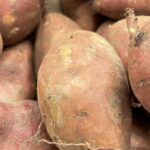
-
Sweet potatoes are a healthy vegetable.
-
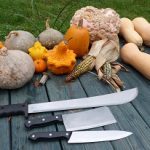
-
Winter Squash vary in color, texture, shape and size.
Chickens
We can’t imagine living without a small chicken flock. Our six to 12 hens gift us a couple of dozen eggs a week. Their manure fertilizes the garden and garden weeds are a great hen chow. During warm months our hens forage in their large run eating bugs, worms, and weeds and transforming them into eggs. Sometimes we even stew down an old hen.
-
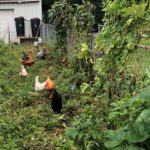
-
In the summer hens find plenty to eat.
-
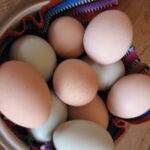
-
The chickens kept on laying eggs.
-
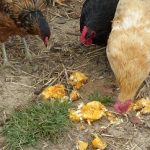
-
Chickens efficiently recycle squash seeds to eggs.
Wildlife
Lots of folks don’t like hunting. For us harvesting a deer is a form of food gathering, not recreation. After all, deer are free-ranging, local, and organic. Fortunately, we’re able to hunt on our property and convert a deer into delicious meat. We also enjoy eating panfish.
Like most folks, we can’t grow or forage all our food but much comes from the yard and area. It takes knowledge and investment in elbow grease but trims the food budget. Perhaps even better, knowing how to find and grow food makes us feel less vulnerable to national disruptions that make food either hard to get or expensive.
by Winding Pathways | Mar 17, 2022 | (Sub)Urban Homesteading, Garden/Yard, Garden/Yard
As we watched squirrels gleaning sunflower seeds from feeders in our backyard, we dined on 2021s sunshine!
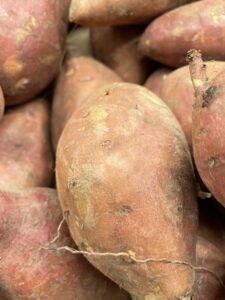
Sweet potatoes are a healthy vegetable.
Thanks to last season’s sun our crop of sweet potatoes produced a bountiful crop, and we ate them until our last one became part of our February 8th dinner. We’ve only been growing sweet potatoes for a few years because we’d heard they need a long southern summer to mature. We now know that’s not true.
We love sweet potatoes. They come in many varieties and color shades from white to purple and the common ones with deep orange flesh. This nutritious plant originated from tropical South America and is now grown in warm regions all over the world. Sometimes they are called yams, but these two plants are distinctly different. Yams originated in Africa.
Nutritious Vegetable
We love the taste and nutrition of sweet potatoes but here are some other ways we love this plant:
- They are easy to grow. We buy “slips” and plant them in late May or early June.
- The plants and flowers are gorgeous, and slips are sometimes sold as ornamentals.
- They store well. We carefully dig them before the first frost, let them cure for a couple of weeks, and then store them in a cool dark place. They last all winter.
Sweet potatoes are easy. No freezing or canning is needed. We plant, weed a bit, dig, cure, and store and then enjoy eating them all winter. This year we’ve ordered a variety of sweet potato slips from Sand Hill Preservation Center and look forward to a larger harvest. The company also sells heritage chicken breeds and vegetable seeds.
by Winding Pathways | Feb 3, 2022 | Birds, Garden/Yard, Nature, Uncategorized
Millions of families love watching chickadees, nuthatches and woodpeckers visit backyard feeders. A joyful daily task is bringing them a day’s supply of sunflower seeds, millet, or even cracked corn. But, often an important part of their diet is ignored.
Birds lack teeth so never need dental care. Instead, they must eat rocks! Small rocks humans call sand. Often birds forage along snowy roads gleaning grit spread to give cars traction. It goes into their gizzard where powerful muscles grind seeds into a digestible slurry that then moves on to the stomach.
During most of the year, birds find all the grit they need on their own, but when snow and ice seal off the soil they can’t find it. People sometimes scatter sand on slippery spots to provide human traction. Birds will glean some of it.
It’s helpful to sprinkle a handful of sand around feeders once a week during the snowy season. At Winding Pathways, we buy a 50-pound bag of chick grit at a local store that sells chicken feed. It’s fine ground hard rock that is ideal for both traction and bird digestion but plain old sand works.
Wild Turkeys often visit our feeders, so once in a while, we toss out large-sized grit, designed for laying hens. It helps their gizzards grind up hard corn kernels that they love snacking on.
An outstanding source of bird information is the Cornell University Laboratory of Ornithology.
-
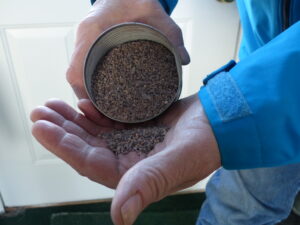
-
Chick grit is small.
-
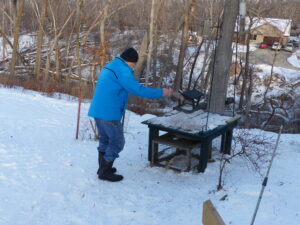
-
Sprinkle grit once a week to help birds in the snowy season.
-
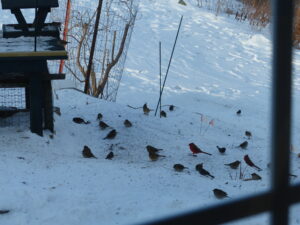
-
Birds flock to the seeds.
by Winding Pathways | Jan 20, 2022 | (Sub)Urban Homesteading, Energy Efficiency, Garden/Yard
Back in October, we took a gamble. We bought an electric snowblower. Our driveway at Winding Pathways is about 440 feet long, and Iowa gets plenty of snow. It’s too much to shovel, so years ago we bought a gas snow blower. It worked for the first winter but then it started throwing belts off the drive wheels. Fixing was tedious and tenuous. So, we sold the beast and bought an EGO battery-powered two-stage snowblower.
We hoped it was a good decision. Would the blower be up to clearing such a long driveway? Would it hold up to hard use?
A heavy wet snowfall on December 28, 2021, gave us a chance to test the new machine. It did just fine. After clearing the entire driveway, the batteries still had charge to them. We could have done more.
It’s our prediction that gasoline-powered lawnmowers, hedge trimmers, blowers, chainsaws, and snow blowers are becoming obsolete. They’ve already been banned in California because they pollute the air more than cars.
Here are aspects of battery tools we like:
- They run quietly and are lightweight.
- No need to risk shoulder injury by pulling a rope to start it up. Just push a switch.
- No need to store gasoline.
- Maintenance is easy. No filters or spark plug to change.
- No fumes.
- Inexpensive to run. It costs less to recharge the battery than to buy an energy equivalent amount of gas.
It looks like our decision will pay off. We’ve now replaced all our gas-burning outdoor equipment with battery equivalents……except for one chainsaw. That may go soon.
Note: Winding Pathways paid the full retail price for this machine.
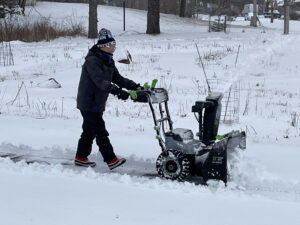
The EGO snowblower cut through the heavy snow easily.




 The distant view and the feel are “Hot August Days.” The near view and sounds are mid-May. With this hot weather, the trees have popped, the fruit trees are in full bloom, and the early garden plants emerging after the cooler and damp weather. We may break a century-old heat record today.
The distant view and the feel are “Hot August Days.” The near view and sounds are mid-May. With this hot weather, the trees have popped, the fruit trees are in full bloom, and the early garden plants emerging after the cooler and damp weather. We may break a century-old heat record today.



